Your browser does not fully support modern features. Please upgrade for a smoother experience.

Submitted Successfully!
Thank you for your contribution! You can also upload a video entry or images related to this topic.
For video creation, please contact our Academic Video Service.
| Version | Summary | Created by | Modification | Content Size | Created at | Operation |
|---|---|---|---|---|---|---|
| 1 | KASHAN KHAN | -- | 3860 | 2023-01-18 12:46:42 | | | |
| 2 | Rita Xu | Meta information modification | 3860 | 2023-01-19 02:56:27 | | |
Video Upload Options
We provide professional Academic Video Service to translate complex research into visually appealing presentations. Would you like to try it?
Cite
If you have any further questions, please contact Encyclopedia Editorial Office.
Khan, K.; Chen, Z.; Liu, J.; Javed, K. Prefabricated Industrial Steel Buildings. Encyclopedia. Available online: https://encyclopedia.pub/entry/40352 (accessed on 13 January 2026).
Khan K, Chen Z, Liu J, Javed K. Prefabricated Industrial Steel Buildings. Encyclopedia. Available at: https://encyclopedia.pub/entry/40352. Accessed January 13, 2026.
Khan, Kashan, Zhihua Chen, Jiadi Liu, Khadija Javed. "Prefabricated Industrial Steel Buildings" Encyclopedia, https://encyclopedia.pub/entry/40352 (accessed January 13, 2026).
Khan, K., Chen, Z., Liu, J., & Javed, K. (2023, January 18). Prefabricated Industrial Steel Buildings. In Encyclopedia. https://encyclopedia.pub/entry/40352
Khan, Kashan, et al. "Prefabricated Industrial Steel Buildings." Encyclopedia. Web. 18 January, 2023.
Copy Citation
Compared to traditional onsite steel construction, prefabricated industrial steel construction (PFISC) saves time, money, and resources. It results in sustainable steel structures that use fewer resources and are better for the environment.
prefabricated industrial steel buildings
automated and detachable IMCs
vertical and horizontal diaphragm continuity IMCs
foundation fixity systems
1. Introduction
Compared to traditional construction, prefabricated industrial construction (PFIC) has recently increased in its importance for modern urbanization. This is because of energy consumption, global expectations, green building, and outstanding structural performance [1][2][3]. It has relied on the industrialization of parts or finished rooms transported and installed using simple connections, as shown in Figure 1 [4][5][6][7][8]. It is widely used in emergencies and repetitive construction projects, such as dwellings, military housing, dorms, clinics, and classrooms [9][10][11]. This has already been introduced in China, the United Kingdom, Japan, Korea, Australia, Germany, the Netherlands, and the United States [1][11][12][13][14][15][16][17]. The UK’s housing industry attempted to accommodate 25% of housing societies, and China’s central and regional governments considered 30–50% with a 2–3% annual increase until 2026 [1][18]. This is sufficient evidence that PFIC is more efficient than the conventional techniques and is essential to meet the housing demand.
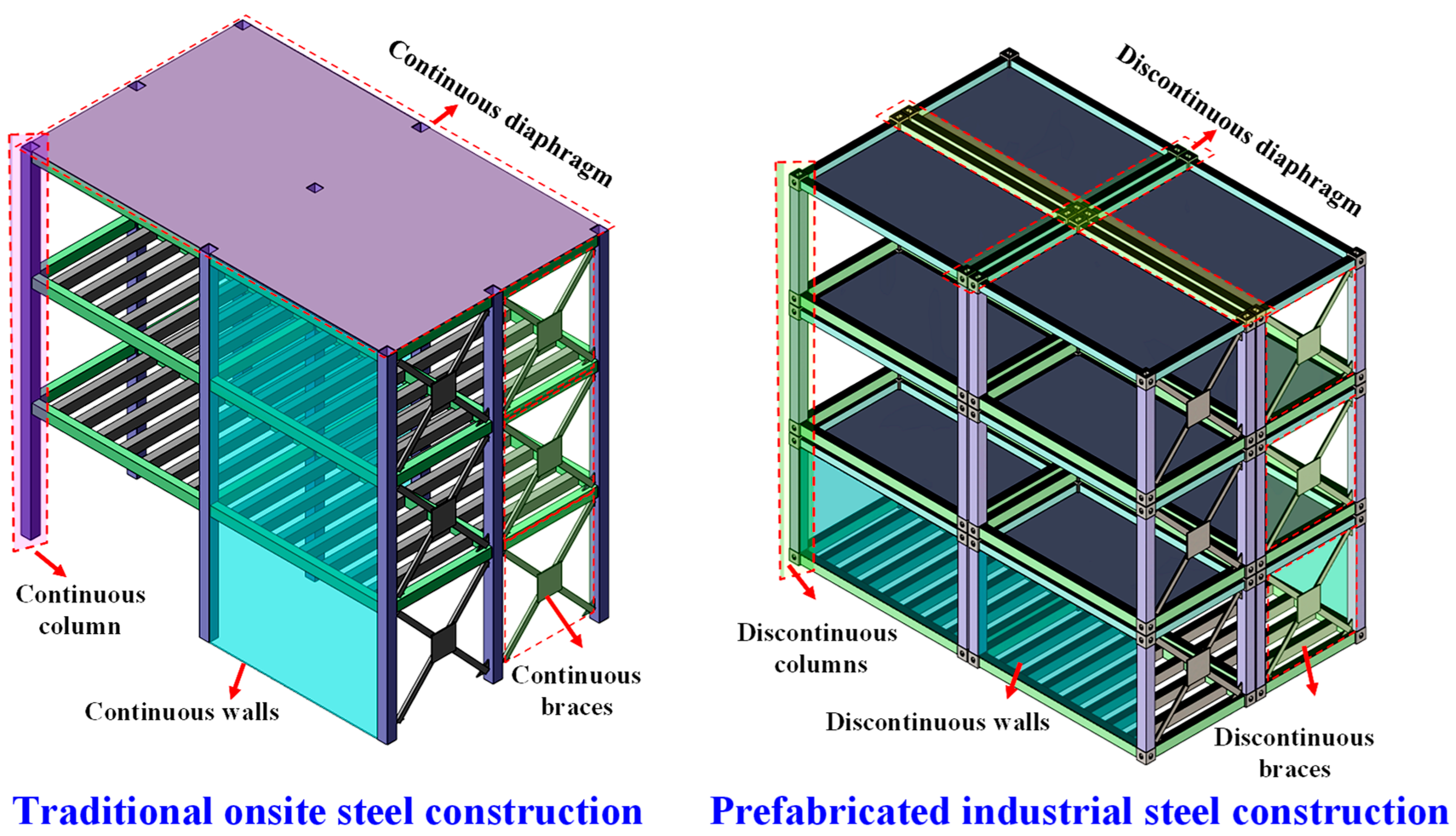
Figure 1. Traditional onsite vs. prefabricated industrial steel construction.
Materials used in PFIC are usually the same as onsite construction, but the components are manufactured under regulated conditions, resulting in better quality industrial modular units (IMUs). However, lightweight materials are always preferred for easy handling, assembly, and transport. Among the materials used in PFIC are steel, concrete, timber, and aluminum. Although aluminum IMUs are lighter, 1.5 times stronger, and have tighter tolerances than steel IMUs, their brittleness and high price remain significant barriers [19]. Timber is often used in low-rise PFIC, whereas steel and concrete have historically been the standard for high-rise PFIC. Steel is preferred over concrete since it is 25–30% lighter, more resilient, and requires fewer joints [20]. Timber necessitates polishing onsite, while concrete demands an accessible base to minimize the self-weight. On the other hand, steel is robust and stiff enough not to be oversized or downsized to obtain prefabricated industrial steel buildings (PFISBs). This inherent strength enables IMUs to withstand oscillations during shipping without requiring support, resulting in reduced transport costs compared to other conventional materials [6]. Including its inherent strength, steel’s structural stability, notably its strength against dynamic loads, increases its preference as a material in high-rise PFISBs, revealing itself to be more affordable than concrete structures. Thus, steel is a favored material choice among architects for high-rise PFISBs [21].
Prefabricated industrial construction displayed an exceptional quality, efficiency, productivity, and versatility. It proved to have shorter project durations, lower overall costs, and the less wastefulness of resources [22]. Therefore, it possesses the potential of a sustainable construction method [23]. Lawson et al. [24] reported an improved sustainability by reducing the construction waste from 10–15%, site visits to 70%, site disruption or noise pollution from 30–50%, and onsite accidents above 80%. Additionally, it was found to lower the environmental impacts by reducing the material wastage to 64%, greenhouse gas emissions to 40% [25], and economic implications by reducing the production hours to 31% [26]. A comparative study concludes that a reduction in the economic impact can be achieved by saving 60% of steel, 77% of the framework [27], and reducing the resource depletion to 36%, a social influence by limiting the health damage to 6.6%, the environmental impact by reducing the ecosystem damage to 3.5%, and economic implications by the reduction in the energy consumption to 20% [28]. It can be concluded that PFIC can increase the productivity, efficiency, and safety while decreasing the number of onsite visits, transport activities, material wastage, noise pollution, energy consumption, hazardous gas emissions, and reliance on unskilled labor. The critical advantage originates from its quick fabrication; this can reduce the construction time by 30–50% compared to conventional construction. In China, broad sustainable building (BSB) was pioneered with the T30 tower [29] in 15 days and the J57 tower [30] in 19 days. The 60-story Collins house, 44-story Atira student accommodation, and La Trobe towers in Australia are the tallest panelized PFISB skyscrapers [31]. The 44-story Croydon tower [32], 32-story B2 tower [33], 29-story Apex [34], and SOHO tower [35] are high-rise volumetric PFISB skyscrapers using PFIC. By developing the two fastest temporary hospitals, i.e., Huoshenshan and Leishenshan, within 6–10 days in Wuhan, China, the PFIC method has fully achieved its goal of being an environmentally friendly, speedy, and dynamic form of construction [36][37].
2. Technological Advancements
2.1. 2D to 3D Assembling Techniques
Prefabricated industrial steel constructions have become increasingly popular recently. They are used in the construction of low-rise structures as well as high-rise PFISB skyscrapers. A Hickory Building System (HBS), consisting of panelized systems to build PFISBs, such as load-bearing walls, concrete floors, and facades, involves integrating and assembling 2D panels onsite to form 3D IMUs through wet joints. The 44-story Atira student accommodation, 60-story Collins house, and 44-story La Trobe towers in Australia used HBS technology [31]. With 80–95% factory-based fabrication, 3D IMUs can be recognized as mobile homes [38]. The 44-story Croydon tower [32], 32-story B2 tower [33], 29-story Apex [34], and SOHO tower [35] used the completely finished 3D IMU. Before moving to the site, the 3D IMU is always fully serviced and prefinished in the factory. HBS systems, on the other hand, are less sustainable because they require an onsite finish and assembly, increasing the complexity and onsite working, reducing the construction productivity. However, compared to traditional steel construction, both panelized and volumetric PFISBs could reduce the construction time by more than 30–50%.
2.2. Industrial Modular Units Forms
Prefabricated industrial steel buildings are classified as continuous and corner-supported [39][40]. Walls which guard continuous supported PFISBs, such as lightweight walls and a hybrid module–barrel system, are developed. The sides of the lightweight wall PFISB are supported by light C-section members that are only suitable for low-rise structures [41][42]. Since they are composed of SHS and can withstand vertical and lateral stresses, the PFISB module–barrel hybrid system, on the other hand, can be employed in high-rise structures [39][41][42][43]. Corner columns in corner-supported PFISB structures principally resist the load. Light and heavy steel IMUs are the corner-supported PFISB. ATLS is a lightweight PFISB that can be built and dismantled multiple times using open, thin-walled, cold-formed sections. They are favored in low-rise structures since their weak connection leads to a minimal structural integrity [44]. SHS columns welded with SHS beams support heavy steel IMUs. Such IMUs are utilized in high-rise PFISBs because of the high bending resistance, lateral–torsional, torsional, and compression of the columns and beams [45][46]. In conclusion, continuous supported module–barrel hybrid PFISB has increased the in-plane rigidity and lateral stability [47]. They have an excellent lateral and longitudinal stability compared to heavyweight corner-supported PFISBs due to load sharing across several columns, making them better suited for high-rise PFISBs [39].
2.3. Manual to Automatic Non-Detachable Inter-Modular Connections
For manually operating PFISBs, inter-modular connections (IMCs) that are welded, bolted, and prestressed are frequently used, as shown in Figure 2a–f. While all of these IMCs have been demonstrated to have an adequate seismic resistance in pertinent investigations, they do have challenges. Due to the extensive onsite work of the welded IMCs, there is not enough room for MEP services, a secure weld quality, and full welding [48]. Welded connections were the most common type of IMC studied by Annan et al. [10][48][49][50] that exhibited a satisfactory performance; nevertheless, they are costly, of a poor quality, and require functional space for internal connection welding [51]. As depicted in Figure 2a, welding connections are avoided due to the aforementioned difficulties; hence, bolted connections are chosen on the construction site [48][52]. Bolted IMCs have strict operational space requirements and a lower production efficiency [53]. Doh et al. [54] discovered that bolted bracket connections were susceptible to prying failure, exhibiting a brittle behavior and are suited for low-rise structures. Thus, Chen et al. [55][56] developed rotary connectors that protect the columns; access holes are used for large bolt tightening, as displayed in Figure 2b [57]. The experiments demonstrated an outstanding bearing capacity and ductility in high-rise PFISB extreme dynamic situations [58]. Plug-in supported joints are developed which can fully assemble interior IMUs, and their seismic performance has been studied, such as the beam and column bolted IMC in Figure 2d [59]; fully bolted IMC in Figure 2e [60]; and beam bolted IMC in Figure 2c [61][62]. They demonstrated a superior ductility, energy dissipation, plastic deformation, and bearing capacity, whereas the weld of the intra-modular joint fractured; nonetheless, the failure was transmitted to the column. The building regulations for the prestressed IMC are stricter and more complicated. Prestressed rebars can join columns vertically, but their limited moment-resistance capability makes them unsuitable for high-rise buildings because superimposed forces can cause elevating and joint failure [63]. In order to achieve the composite prestressed joint shown in Figure 2f, the columns are filled with concrete. This joint effectively transfers medium-level lateral forces in a ductile manner due to the contact bond between the concrete, plug-in, strands, and shear bloc; however, a significant bond reduction can cause concrete crushing, a gap formation, strength, and stiffness degradation [64][65]. Workers may also bolt or weld the corners and exterior interface from the outside. The IMUs’ wall panels and slabs, particularly the installation, do not have the necessary construction clearance for the internal IMC. Some IMCs do not make the final IMU tighter. Others, on the other hand, prefer to make holes in order to assemble them, which may compromise the IMUs’ sectional integrity and interior design. In order to address the problems above, various automatic IMCs that require no functioning space have recently been developed, as shown in Figure 3a–g. The researchers designed a sliding bloc IMC that joins the IMU via a self-locking setup, as shown in Figure 3a [51]. The joining method resembles the lock-tongue joint in Figure 3f in appearance [66]. Another investigation also created the self-locking slider joint displayed in Figure 3e which works similarly with the joins in Figure 3a,f [67]. The top movable panel and springs are attached to the side of the bottom IMU column, and the plug is attached to the base of the upper IMU column. As a result, the connector is fixed, the slider panels move laterally during the mounting of the IMU, and a slip forms between the top and bottom segments of the plug. Self-locking connections’ hysteresis behavior featured plumper hysteretic rings and worked well in seismic tests. Since their initial stiffnesses were comparable to those of the welding connection, they were just as dependable as the welding IMC. The problem with these connections was that they only fixed two sides by locking sliders on two sides, leaving the other sides loose or unsupported, which made them weaker in earthquake-prone areas. Therefore, to achieve the fixity of the tubes and IMC in opposite and neighboring four sides, researchers developed pin-type joints, as shown in Figure 3c [68], and plug-in type joints, as shown in Figure 3d [69], inserted inside columns, which further improved their seismic performance and made them suitable for mid- to high-rise PFISBs. Other researchers, such as Dai et al. [70] and Picard [71], depicted in Figure 3b,g, built an installation-friendly self-locking fastener machine by using springs and nuts and bolts to provide support around the bolt shaft. Their seismic performance shows that they behave as semi-rigid to rigid in high-seismic zones, making them suitable for usage in high-rise PFISBs. However, these self-locking IMCs ignore construction or deformation tolerances, which require a high degree of precision. Additionally, these IMCs cannot be removed once locked, making it challenging to reuse the IMU in the event of accidental damage during servicing.
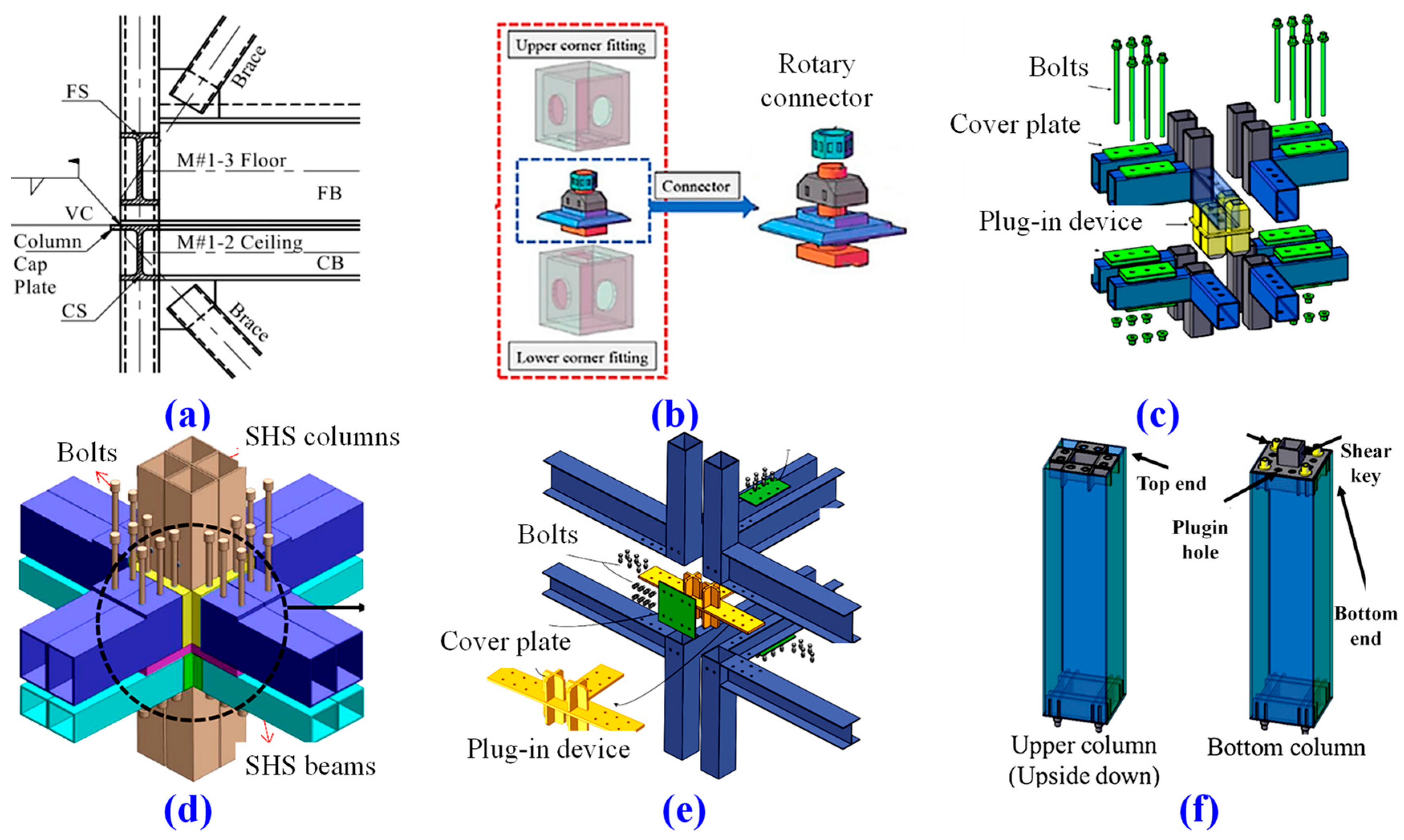

2.4. Manual to Automatic Detachable Inter-Modular Connections
Inter-modular connections cannot be removed once locked, making it challenging to reuse the IMU in the event of accidental damage during servicing. Because of this issue, researchers created bolted and pin types of IMCs through SHS, as shown in Figure 4a–d. They consider the constructional tolerance brought on by the automatic mechanical IMC and the repetitive use of IMUs via a replaceable or detachable IMC. The threaded block of the lower IMU is tightened to the bolt of the upper IMU using a long twisted rod that the researchers designed for the detachable IMC shown in Figure 4a [66] and pinned joint shown in Figure 4d [72]. Although these joints are detachable, tightening the bolts inside the columns requires a lengthy rod tool, which is laborious; hence, the bolt diameter or screwing length is typically small, reducing their seismic and lifting capacities. Consequently, as shown in Figure 4b, a mechanical replacement has recently been developed to address these difficulties. A new, low-carbon mechanical IMC integrates the IMU horizontally and vertically through linearly translating the pins and transfer plates. An extended twisting rod is used in this connection to operate the mechanical arrangement of the components and pin them together [73][74]. As soon as the bolt is turned, horizontal pins instantly lock into place and establish a solid connection between the IMUs on the exterior and interior. These joints perform reliably in seismic and pullout operations. Because these bolted joints are only helpful in tightening or demounting corner and hollow columns, researchers created a new way to connect the beams rather than the columns without the need for any tightening equipment, as depicted in Figure 4c. The onsite fastening connections are replaced by a robust mechanical interconnecting system that allows for twist, tilt, and slide adjustments [75]. However, the joining system cannot withstand the tensile stresses, which forces the use of pricey adhesives and causes the uplift under extremely high lateral loads.

2.5. Lateral Loads Stabilizing Systems
Lateral stability systems are developed, including braces, shear walls, diaphragm walls, cores, base isolators, and viscoelastic dampers to resist the effect of lateral forces on high-rise PFISBs due to the incapability of the IMCs. As seen in Figure 5a–d and Figure 6a–f, IMCs have recently been invented. According to Sultana et al., superelastic self-centering SMA bracing and SMA bolts’ IMC minimizes the residual stresses and is a recyclable solution [76][77]. Through self-centering, the haunch bracing system proposed in Figure 6c improved the IMCs’ ductility [60]. Recently, a slider device with reusable bonded rubber units was devised [78][79][80][81][82]. After 5 mm of torsion and translation, they may dissipate 80% of the earthquake energy through friction. The haunch bracing with a plug-in IMC transferred the failure from the joints to the beams and demonstrated superior self-centering systems that may be used in high seismic zones for mid- to high-rise PFISBs. Moreover, the PFISBs’ and system’s full strength can be achieved using a double-skin steel shear wall, as shown in Figure 6b [83]. The composite action of the Corefast 2D and 3D walls increases the fire resistance while attempting to prevent the lateral force damage, as shown in Figure 6f [6]. This is a functional lateral force-resisting system because it delays the structure’s yield, increases the elastic stiffness with a yielding wall panel, and prevents out-of-plane buckling prematurely while causing column tearing and strength degradation due to local buckling [83]. However, the lateral stability offered by these stabilizing systems is limited because the upper and lower IMUs’ interconnectivity is lacking in regions other than the column corners. As per evaluation, the linked wall systems made up of numerous vertical bars and sleeves could aid structures with the superior lateral response, as shown in Figure 6d [84] and Figure 6e [85]. They rigidly connect vertical diaphragms using a composite connection between the walls using bars. Recently, one of the researchers patented a base isolation technology, as shown in Figure 6a [86]. This satisfies the requirements for the standard use, structural bearing capacity, and an effective resistance to the effects of earthquakes. However, they are suitable for pre-tensioned and composite types of IMCs inside the columns of PFISBs. Therefore, other energy dissipation joints are developed; for instance, the researchers invented a rubber isolation system [87] and a self-locking tenon-and-mortise vibration isolation rubber IMC in the IMU, as shown in Figure 5a,b [88]. The invention may reduce the adverse effects of earthquakes and improve the PFISB structure’s bearing capacity. Similarly, two distinct configurations of bolted IMCs having washer and resilient rubber layers are demonstrated, as shown in Figure 5d [89]. It has been shown that the IMCs which have been bolted are rigid and cause a column fracture, as opposed to the IMC in Figure 5d, which has been strengthened with resilient layers which can withstand significant deformations without fracturing the bolt [89]. A lead viscoelastic damper in a vertical IMC dissipated more energy than the conventional bolted IMC, such as those shown in Figure 3a–f and Figure 4a–d [90]. The damping joints in Figure 5a–d have the effect of delaying the premature failure of the structural components. They prevent a failure and collapse, increase the capacity, and guarantee security.

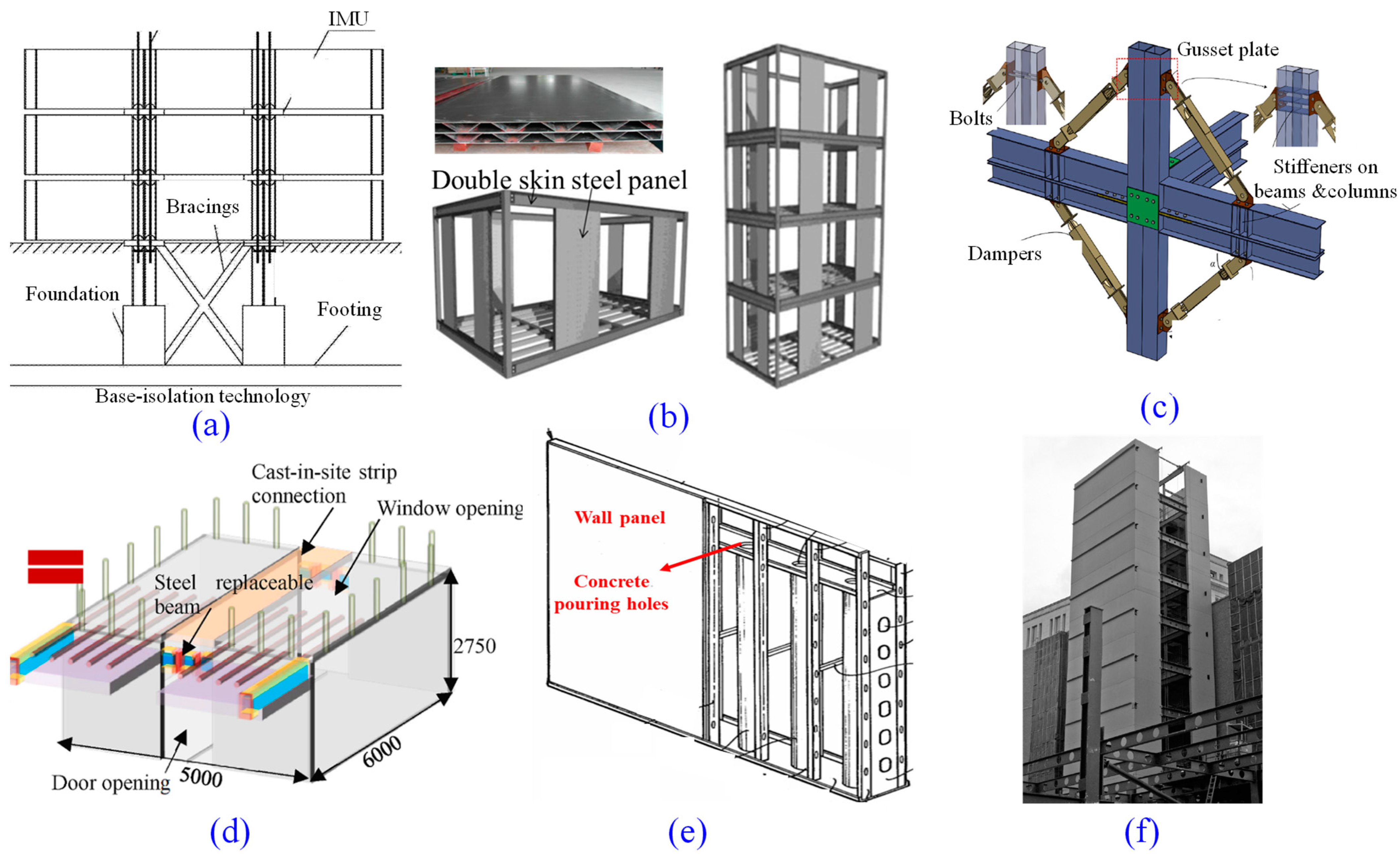
2.6. Top-Down Assembling Approach
The recently developed “Top-Down approach” involves building a structure from the top floor to the first floor [91]. The structural frame was designed with a hydraulic jack lifting system, eliminating the need for large cranes. The system can elevate the PFISBs’ structure while supporting the horizontal loads, minimizing swaying, and ensuring the structure’s integrity. Furthermore, it eliminates the need for scaffolding and cranes when operating at a height, improving the worker safety and reducing the time and labor expenses. The advantages include unloading, directly inserting the IMUs from the truck into the frame, and permitting working space around the cluster columns at the base. According to the frame type, this could be classified as essential or extended systems [92]. The frame is packed with a steel IMU created individually. Through the use of peripheral moment-frames, the lateral stability is enhanced.
2.7. Vertical and Horizontal Diaphragm Continuity Systems
There were significant problems with the PFISBs’ in-plane stiffness and non-uniform lateral force transmission because of the discontinuity between the floor and wall diaphragms and no adequate connection system developed on the beams. In order to address the issues mentioned earlier, the researchers most recently created a horizontal IMC using the tongues and grooves between the beams, as shown in Figure 7a [88]. Sharafi et al. [75] also designed a horizontal and vertical beam IMC that resists shear forces and provides a diaphragm continuity in both horizontal and vertical directions, as shown in Figure 7c. Both methods required expensive adhesives or a corner column–column IMC to fix because they could not withstand the uplift stresses. In order to offer horizontal and vertical diaphragm connectivity and an adequate lateral force resistance, the recent developments in the IMC, such as the wall-to-wall vertical shown in Figure 7d [93] and diaphragm-to-diaphragm horizontal IMC shown in Figure 7e [94], have been made. They had a sustainability challenge because extensive site work would be required. In order to accomplish a connection at diverse locations, another sustainable approach has been devised that uses field bolts to attach the IMU horizontally and vertically by welding angles to the beam flanges in both directions, as illustrated in Figure 7b [95].
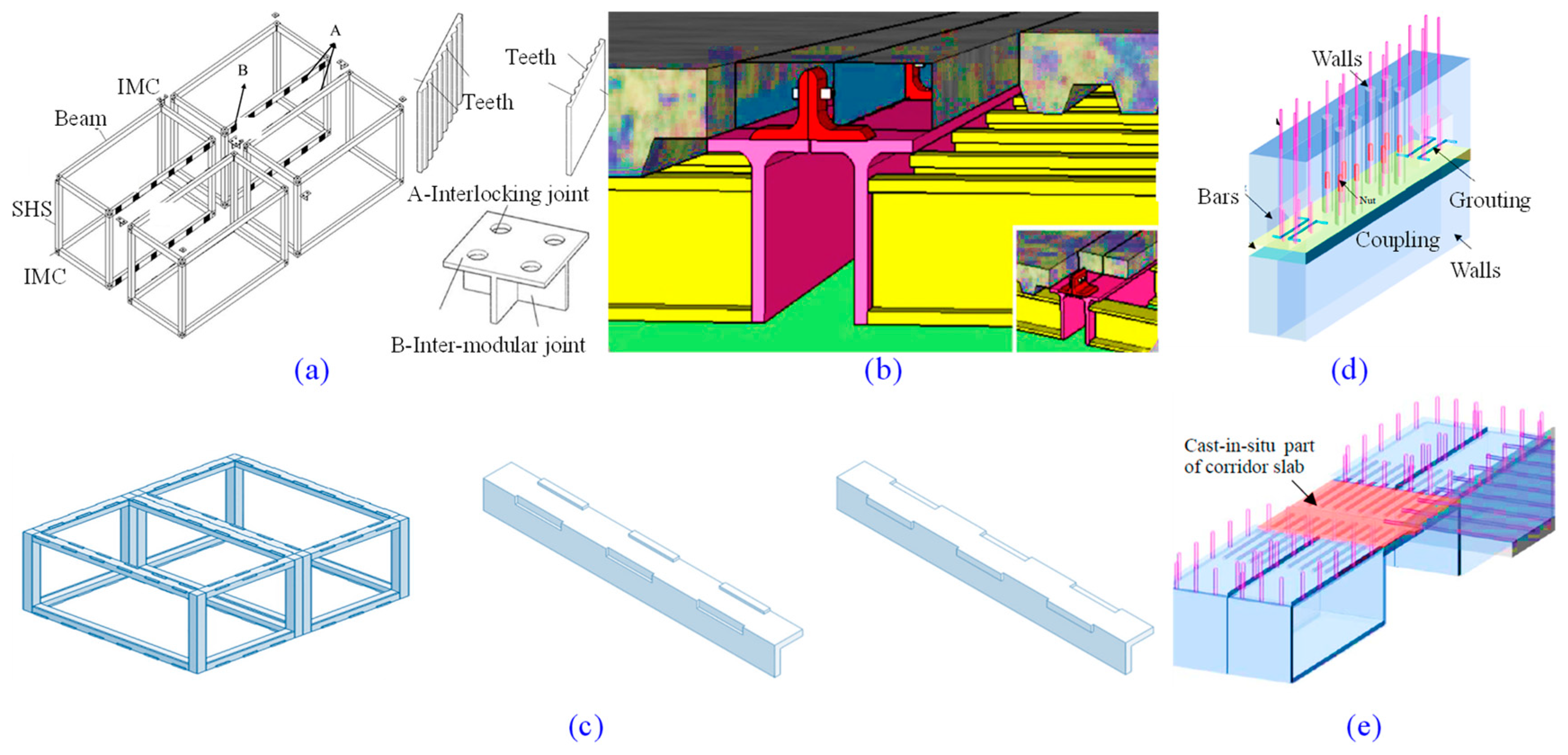
Figure 7. IMC for the continuous horizontal and vertical diaphragm. (a) beam-to-beam horizontal teeth lock [88]; (b) beam-to-beam vertical bolted clips [95]; (c) beam-to-beam horizontal and vertical sawed systems [75]; (d) wall-to-wall vertical cast-in situ rebars [93]; and (e) diaphragm-to-diaphragm horizontal cast-in situ rebars [94] IMC.
2.8. Automated and Robotized Systems
Due to the congested gaps between IMUs, fully finished 3D IMU-fitted PFISBs have difficulties installing MEP facilities. A single 3D file combining architectural, structural, and MEP data allowed for the effective implementation of the BIM to visualize and identify hundreds of conflicts between MEP and structural systems [96]. Additionally, to lessen the IMUs and component damage during transit, both structural and nonstructural. The conveyance of IMUs is planned, optimized, and visualized using the integrated BIM platform, Geographic Information System (GIS), and Vehicle Routing Problem (VRP) [97]. The system was discovered to track the environment, the network of roads, and the best route for the safe transfer of IMUs. The traditional manual techniques for configuring, choosing, and positioning the cranes remained dangerous; as a result, the Hevilift automated crane planning and optimization approach to effectively deploy thousands of cranes simultaneously has recently been implemented [98]. The robotized crane assembly with automation allowed the IMUs to be hoisted and installed with outstanding autopilot precision and safety, greatly enhancing the safety and sustainability of PFISBs [99].
2.9. Foundation Fixity Systems
Due to the close proximity of the four columns in the PFISBs, they are more prone to sliding and overturning when subjected to high lateral loads; as a result, an adequate restraint is needed at the base. The appropriate foundations, such as the combine, raft, or pile foundations, can be adapted depending on the construction height and requirement to withstand the lateral load. Concrete spread footings are advised for small structures on good soil, mat foundations for large structures, and pile footings for soft soils, depending on the size of the structure, the type of soil, and economic considerations [100]. To fix the IMU by IMC blocs or IMU column base plate, as designed by several studies in Table 1, onsite casting, bolting to accessible onsite cast plates, or welding to accessible onsite cast plates can be used.
Table 1. Foundation IMCs and relevant PFISB studies.
| Type | Detailing | Analysis | Features |
|---|---|---|---|
| Anchor IMC [10] |
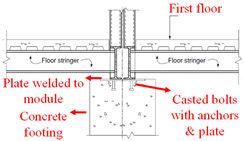 |
No reported studies on structural behavior evaluation | Suitable for high-rise PFISBs, with the ability to withstand uplift, shear stress, and moment owing to anchors cast onsite and welded to the base plate. |
| Anchor IMC [101] |
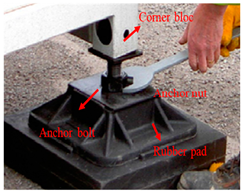 |
No reported studies on structural behavior evaluation | The anchor and plate can be welded to the rubber-pad footing and are suited for the low- to mid-rise PFISBs because it resists uplift, shear stress, and moment. |
| Key IMC [101] |
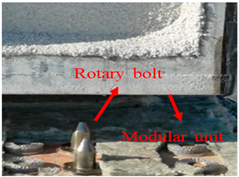 |
No reported studies on structural behavior evaluation | Shear-key in the IMU can withstand shear force and a small moment but is dangerous when subjected to uplifting forces and is not suitable for high-rise PFISBs. |
| Anchor IMC [102] |
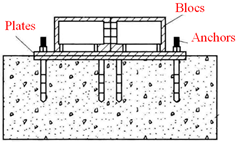 |
No reported studies on structural behavior evaluation | To resist uplift, shear force, and moment in high-rise PFISBs, the base plate is welded to the connecting plate that has been anchor-welded. |
| Stud IMC [103] |
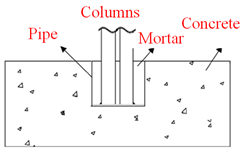 |
 |
It can withstand uplift, shear stress, and moment and prevent uplifting while producing ductile failure, but it can also start brittle failure in high-rise PFISBs with infilled moment-frames. |
| Bolted IMC [55][56][58][104] | 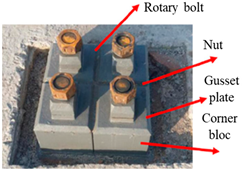 |
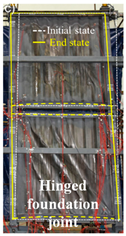 |
They are effectively used in a five-story PFISB in China, where bolts are tightened onsite using nuts, preventing the IMU from rising and resisting uplift, shear strain, and severe moments. |
| Welded IMC [100] |
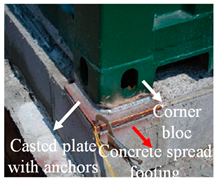 |
No reported studies on structural behavior evaluation | The onsite welded plate has high stiffness and strength and can resist uplift, shear force, and moment. However, full welding is difficult; thus, best suited for mid-rise PFISBs. |
| Key IMC [105] |
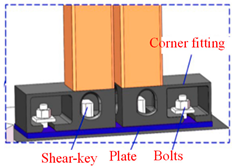 |
No reported studies on structural behavior evaluation | Although onsite anchors are cast with shear keys and connecting plates, they can resist uplift, shear force, and moment; interior bolting presents a barrier. |
References
- Xu, Z.; Zayed, T.; Niu, Y. Comparative analysis of modular construction practices in mainland China, Hong Kong and Singapore. J. Clean. Prod. 2019, 245, 118861.
- Arif, M.; Egbu, C. Making a case for offsite construction in China. Eng. Constr. Arch. Manag. 2010, 17, 536–548.
- Srisangeerthanan, S.; Hashemi, M.J.; Rajeev, P.; Gad, E.; Fernando, S. Numerical study on the effects of diaphragm stiffness and strength on the seismic response of multi-story modular buildings. Eng. Struct. 2018, 163, 25–37.
- Alembagheri, M.; Sharafi, P.; Hajirezaei, R.; Samali, B. Collapse capacity of modular steel buildings subject to module loss scenarios: The role of inter-module connections. Eng. Struct. 2020, 210, 110373.
- Monash University. Modular Construction Codes Board, Handbook for the Design of Modular Structures; Monash University: Melbourne, VC, Australia, 2017.
- Lawson, M.; Ogden, R.; Goodier, C. Design in Modular Construction; CRC Press: Boca Raton, FL, USA, 2014.
- Smith, R.E. Prefab Architecture: A Guide to Modular Design and Construction; John Wiley & Sons: Hoboken, NJ, USA, 2011.
- Barnes, P. Off-site fabrication. BIM Princ. Pract. 2019, 109–112.
- Kim, J.-Y.; Lee, J.-K. A Basic Study on the Application of Modular Construction—Focused on the Analysis of Case Study. J. Korean Hous. Assoc. 2014, 25, 39–46.
- Annan, C.; Youssef, M.; El-Naggar, M. Effect of Directly Welded Stringer-To-Beam Connections on the Analysis and Design of Modular Steel Building Floors. Adv. Struct. Eng. 2009, 12, 373–383.
- Fathieh, A.; Mercan, O. Seismic evaluation of modular steel buildings. Eng. Struct. 2016, 122, 83–92.
- Kildsgaard, I.; Jarnehammar, A.; Widheden, A.; Wall, M. Energy and Environmental Performance of Multi-Story Apartment Buildings Built in Timber Construction Using Passive House Principles. Buildings 2013, 3, 258–277.
- Jiang, R.; Mao, C.; Hou, L.; Wu, C.; Tan, J. A SWOT analysis for promoting off-site construction under the backdrop of China’s new urbanisation. J. Clean. Prod. 2018, 173, 225–234.
- Steinhardt, D.A.; Manley, K. Adoption of prefabricated housing–the role of country context. Sustain. Cities Soc. 2016, 22, 126–135.
- Gunawardena, T.; Me, P. Steel Modular Construction and Its Applicability to the Building Industry in China. Steel Constr. 2020, 35, 66–73.
- Li, H.; Al-Hussein, M.; Lei, Z.; Ajweh, Z. Risk identification and assessment of modular construction utilizing fuzzy analytic hierarchy process (AHP) and simulation. Can. J. Civ. Eng. 2013, 40, 1184–1195.
- Larsson, M.; Kaiser, A.; Girhammar, U. Multi-storey modular manoeuvres—Innovative architectural stacking methodology based on three Swedish timber building systems. World Conf. Timber Eng. 2012, 4, 63–72.
- Boyd, N.; Khalfan, M.M.A.; Maqsood, T. Off-Site Construction of Apartment Buildings. J. Archit. Eng. 2013, 19, 51–57.
- Bowick, C.; Blyler, J.; Ajluni, C. Components and Systems;Modular construction-Design structure new technologies, Detail. Struct. New Technol. 2008, 1–21.
- English, S.; Brwon, B. An Introduction to Steel and Concrete Modular Construction. In Proceedings of the Residential Building Design & Construction Conference, Bethlehem, PA, USA, 20–21 February 2013; pp. 326–333.
- Ferrer, M.A. Modular Construction in Multi-Storey Buildings; Euskal Herriko Unibertsitatea: Leioa, Spain, 2019.
- Musa, M.F.; Mohammad, M.F.; Mahbub, R.; Yusof, M.R. Enhancing the Quality of Life by Adopting Sustainable Modular Industrialised Building System (IBS) in the Malaysian Construction Industry. Procedia Soc. Behav. Sci. 2014, 153, 79–89.
- Marjaba, G.; Chidiac, S. Sustainability and resiliency metrics for buildings—Critical review. Build. Environ. 2016, 101, 116–125.
- Lawson, R.M.; Ogden, R.G.; Bergin, R. Application of Modular Construction in High-Rise Buildings. J. Arch. Eng. 2012, 18, 148–154.
- Quale, J.; Eckelman, M.J.; Williams, K.W.; Sloditskie, G.; Zimmerman, J.B. Construction Matters: Comparing Environmental Impacts of Building Modular and Conventional Homes in the United States. J. Ind. Ecol. 2012, 16, 243–253.
- Nahmens, I.; Ikuma, L.H. Effects of Lean Construction on Sustainability of Modular Homebuilding. J. Arch. Eng. 2012, 18, 155–163.
- Jiang, Y.; Zhao, D.; Wang, D.; Xing, Y. Sustainable Performance of Buildings through Modular Prefabrication in the Construction Phase: A Comparative Study. Sustainability 2019, 11, 5658.
- Cao, X.; Li, X.; Zhu, Y.; Zhang, Z. A comparative study of environmental performance between prefabricated and traditional residential buildings in China. J. Clean. Prod. 2015, 109, 131–143.
- The Skyscraper Center. T30 Hotel. 2015. Available online: https://www.skyscrapercenter.com/building/t30-hotel/14432 (accessed on 12 February 2021).
- The Skyscraper Center. J57 Mini Sky City. 2015. Available online: https://www.skyscrapercenter.com/building/j57-mini-sky-city/19743 (accessed on 12 February 2021).
- Hickory Group. Hickory Building Systems-Overview of Prefabricated Structural System. Hickory Build. Innov. 2017, 1–19.
- Wellman, P. Record-Breaking Croydon Tower Gets the Go-Ahead, Radius. 2017. Available online: https://www.egi.co.uk/news/899337/.
- Farnsworth, D. Modular Tall Building Design at Atlantic Yards B2. In Proceedings of the CTBUH 2014 Shanghai Conference, Shanghai, China, 16–19 September 2014; pp. 492–499.
- Blog, L.S.E.L.H. Apex Tower: Modern Prefab Construction Techniques Delivering Housing London Needs; Accel: London, UK, 2017; pp. 1–6.
- Gardiner, P. The Construction of a High-Rise Development Using Volumetric Modular Methodology. Counc. Tall Build. Urban Habitat 2015, 136–143. Available online: https://global.ctbuh.org/resources/papers/download/2411-the-construction-of-a-high-rise-development-using-volumetric-modular-methodology.pdf?utm_source=hootsuite.
- Gu, D.; Zheng, Z.; Zhao, P.; Xie, L.; Xu, Z.; Lu, X. High-Efficiency Simulation Framework to Analyze the Impact of Exhaust Air from COVID-19 Temporary Hospitals and its Typical Applications. Appl. Sci. 2020, 10, 3949.
- Fifield, L.; Lomas, K.; Giridharan, R.; Allinson, D. Hospital wards and modular construction: Summertime overheating and energy efficiency. Build. Environ. 2018, 141, 28–44.
- Boafo, F.E.; Kim, J.-H.; Kim, J.-T. Performance of Modular Prefabricated Architecture: Case Study-Based Review and Future Pathways. Sustainability 2016, 8, 558.
- Hou, J.; Wang, X.; Liu, J.; Chen, Z.; Zhong, X. Study on the stability bearing capacity of multi-column wall in modular steel building. Eng. Struct. 2020, 214, 110648.
- Lawson, R.; Ogden, R.; Pedreschi, R.; Grubb, P.; Popo-Ola, S. Developments in pre-fabricated systems in light steel and modular construction. Struct. Eng. 2005, 83, 28–35.
- Khan, K.; Chen, Z.; Liu, J.; Khan, A. Experimental and numerical study on planar multi-column walls behaviours with boundary supports. J. Constr. Steel Res. 2021, 186, 106880.
- Khan, K.; Chen, Z.; Liu, J.; Khan, A. Numerical and parametric analysis on compressive behaviours of continuous-supported wall systems in MSB. Structures 2021, 33, 4053–4079.
- Khan, K.; Chen, Z.; Liu, J.; Khan, A.; Javed, K. Axial compression behaviours of tubular sectioned C-shape continuous-supported steel walls in MSB. J. Constr. Steel Res. 2021, 188, 107009.
- Zhang, J.-F.; Zhao, J.-J.; Yang, D.-Y.; Deng, E.-F.; Wang, H.; Pang, S.-Y.; Cai, L.-M.; Gao, S.-C. Mechanical-property tests on assembled-type light steel modular house. J. Constr. Steel Res. 2020, 168.
- Nakashima, M.; Tateyama, E.; Morsako, K.; Suita, K. Full-scale test on plastic rotation capacity of steel wide-flange beams connected with square tube steel columns. Steel Constr. Eng. 1997, 4, 59–74. (In Japanese)
- Fadden, M.; Wei, D.; McCormick, J. Cyclic Testing of Welded HSS-to-HSS Moment Connections for Seismic Applications. Eng. Struct. 2015, 141, 04014109.
- Lawson, R. Light Steel Modular Construction High-rise modular building, London Three storey modular office building Modular residential building Four Sided Modules Form of construction. SCI Steel Knowl. 2016, 1–8.
- Annan, C.D.; Youssef, M.A.; El Naggar, M.H. Seismic Overstrength in Braced Frames of Modular Steel Buildings. J. Earthq. Eng. 2008, 13, 1–21.
- Annan, C.D.; Youssef, M.A.; El-Naggar, M.H. Analytical investigation of semi-rigid floor beams connection in modular steel structures. In Proceedings of the 33rd Annual General Conference of the Canadian Society for Civil Engineering, Toronto, ON, Canada, 2–4 June 2015.
- Annan, C.D.; Youssef, M.; El Naggar, M.H. Seismic Vulnerability Assessment of Modular Steel Buildings. J. Earthq. Eng. 2009, 13, 1065–1088.
- Chen, Z.; Wang, J.; Liu, J.; Khan, K. Seismic behavior and moment transfer capacity of an innovative self-locking inter-module connection for modular steel building. Eng. Struct. 2021, 245, 112978.
- Liew, J.Y.R.; Chua, Y.S.; Dai, Z. Steel concrete composite systems for modular construction of high-rise buildings. Structures 2019, 21, 135–149.
- Lacey, A.W.; Chen, W.; Hao, H.; Bi, K. Review of bolted inter-module connections in modular steel buildings. J. Build. Eng. 2019, 23, 207–219.
- Doh, J.-H.; Ho, N.M.; Miller, D.; Peters, T.; Carlson, D.; Lai, P. Steel Bracket Connection on Modular Buildings. J. Steel Struct. Constr. 2017, 2, 2472–0437.
- Chen, Z.; Wang, J.; Liu, J.; Cong, Z. Tensile and shear performance of rotary inter-module connection for modular steel buildings. J. Constr. Steel Res. 2020, 175, 106367.
- Chen, Z.; Liu, Y.; Zhong, X.; Liu, J. Rotational stiffness of inter-module connection in mid-rise modular steel buildings. Eng. Struct. 2019, 196, 109273.
- Singh, T.G.; Chan, T.-M. Effect of access openings on the buckling performance of square hollow section module stub columns. J. Constr. Steel Res. 2020, 177, 106438.
- Liu, Y.; Chen, Z.; Liu, J.; Bai, Y.; Zhong, X.; Wang, X. Lateral stiffness evaluation on corner-supported thin walled modular steel structures. Thin-Walled Struct. 2020, 157, 106967.
- Khan, K.; Yan, J.-B. Finite Element Analysis on Seismic Behaviour of Novel Joint in Prefabricated Modular Steel Building. Int. J. Steel Struct. 2020, 20, 752–765.
- Zhang, G.; Xu, L.-H.; Li, Z.-X. Development and seismic retrofit of an innovative modular steel structure connection using symmetrical self-centering haunch braces. Eng. Struct. 2020, 229, 111671.
- Chen, Z.; Liu, J.; Yu, Y. Experimental study on interior connections in modular steel buildings. Eng. Struct. 2017, 147, 625–638.
- Chen, Z.; Liu, J.; Yu, Y.; Zhou, C.; Yan, R. Experimental study of an innovative modular steel building connection. J. Constr. Steel Res. 2017, 139, 69–82.
- Pang, S.D.; Liew, J.Y.R.L.; Dai, Z.; Wang, Y. Prefabricated Prefinished Volumetric Construction Joining Tech-niques Review. In Proceedings of the 2016 MOC Summit: Edmonton, Edmonton, AB, Canada, 29 September–1 October 2016.
- Chen, Z.; Li, H.; Chen, A.; Yu, Y.; Wang, H. Research on pretensioned modular frame test and simulations. Eng. Struct. 2017, 151, 774–787.
- Yu, Y.; Chen, Z.; Chen, A. Experimental study of a pretensioned connection for modular buildings. Steel Compos. Struct. 2019, 31, 217–232.
- Liu, J.; Wang, J.; Chen, Z. Lock Tongue Type Modular Building Self-Locking Connection Joint. CN 212478104U, 5 February 2021. (In Chinese).
- Liu, J.; Chen, Z.; Wang, J. Sliding Block Type Modular Building Self-Locking Connection Node. CN 111287331A, 16 June 2020. (In Chinese).
- Ding, Y.; Dai, X.; Zong, L. A Self-Locking Connector with a Rotating Snap-Shot Insert between Modular Steel Components. CN 106996145A, 1 August 2017. (In Chinese).
- Yan, J.-B.; Wang, N. A Modular Combined Structure Automatically Connects Joint. CN 208396012U, 26 June 2018. (In Chinese).
- Dai, X.-M.; Zong, L.; Ding, Y.; Li, Z.-X. Experimental study on seismic behavior of a novel plug-in self-lock joint for modular steel construction. Eng. Struct. 2018, 181, 143–164.
- Picard, L.; Blanchet, P.; Bégin-Drolet, A. Assembly Solution for Modular Buildings: Development of an Automated Connecting Device for Light-Framed Structures. Buildings 2022, 12, 672.
- Yan, J.-B.; Wang, N. A Modular Composite Structure Components Joint. CN 208396103U, 18 January 2019. (In Chinese).
- Dissanayake, R.; Mendis, P.; Weerasekera, K.; De Silva, S. (Eds.) ICSECM 2019-Proceeding of the 10th International Conference on Structural Engineering and Construction Management; Springer: Singapore, 2019.
- Swinburne University of Technology (SUT). Development and Optimisation of Low-Carbon, Affordable, Medium-Rise Modular Structural System Using innovAtive Connections; Swinburne University of Technology: Hawthorn, VIC, Australia, 2021.
- Sharafi, P.; Mortazavi, M.; Samali, B.; Ronagh, H. Interlocking system for enhancing the integrity of multi-storey modular buildings. Autom. Constr. 2018, 85, 263–272.
- Sultana, P.; Youssef, M.A. Seismic Performance of Modular Steel-Braced Frames Utilizing Superelastic Shape Memory Alloy Bolts in the Vertical Module Connections. J. Earthq. Eng. 2018, 24, 628–652.
- Sultana, P.; Youssef, M.A. Seismic performance of modular steel frames equipped with shape memory alloy braces. Bull. Earthq. Eng. 2018, 16, 5503–5527.
- Jing, J. Seismic Damage-Resistant System for Modular Steel Structures; The University of Auckland: Auckland, New Zealand, 2016.
- Jing, J.; Clifton, G.C.; Roy, K.; Lim, J.B. Three-storey modular steel building with a novel slider device: Shake table tests on a scaled down model and numerical investigation. Thin-Walled Struct. 2020, 155, 106932.
- Jing, J.; Clifton, G.C.; Roy, K.; Lim, J.B. Performance of a novel slider device in multi-storey cold-formed steel modular buildings under seismic loading. Structures 2020, 27, 212–246.
- Jing, J.; Clifton, G.C.; Roy, K.; Lim, J.B. Seismic protection of modular buildings with bonded rubber unit sliders: Experimental study. Thin-Walled Struct. 2020, 154, 106790.
- Jing, J.; Clifton, G. Seismic Damage-Resistant System for Multi-Storey Modular Light Steel Framed Buildings. In Proceedings of the Australian Earthquake Engineering Society 2016 Conference, Melbourne, VIC, Australia, 25–27 November 2016.
- Hong, S.-G.; Cho, B.-H.; Chung, K.-S.; Moon, J.-H. Behavior of framed modular building system with double skin steel panels. J. Constr. Steel Res. 2011, 67, 936–946.
- Wang, Z.; Pan, W. A hybrid coupled wall system with replaceable steel coupling beams for high-rise modular buildings. J. Build. Eng. 2020, 31, 101355.
- Shubow, C. Concrete Reinforced Wall Modules for Use in Building Construction. U.S. Patent No. 4,357,783, 9 November 1982.
- Chen, Z.; Qin, Y.; Wang, X.; Xin, Q. Modular Building Seismic Isolation System. CN 102912878A, 6 February 2013. (In Chinese).
- Chen, Z.; Chen, S.; Zhou, T.; Liu, J. A Rubber Isolation System between Columns of Steel Modular Building. CN 110397176A, 1 November 2019. (In Chinese).
- Chen, Z.; Zhong, X.; Liu, Y.; Liu, J. Horizontal interlocking connection structure for modular building. CN 209874063 U, 31 December 2019. (In Chinese).
- Sendanayake, S.V.; Thambiratnam, D.P.; Perera, N.; Chan, T.; Aghdamy, S. Seismic mitigation of steel modular building structures through innovative inter-modular connections. Heliyon 2019, 5, e02751.
- Wu, C.; Yang, Y.; Wu, C.; Yang, T.; Xu, X. Research on siesmic behavior of shock absorbing structure and connecting joints of container assembly structures. Steel Constr. 2019, 34, 1–9. (In Chinese)
- Andrade, P. Structural Assessment and Optimization of the Modular System of a Student Residential Building in Luleå and Coimbra Affordable Houses Project. Master’s Thesis, Luleå University of Technology, Luleå, Sweden, 2016.
- Di Pasquale, J.; Innella, F.; Bai, Y. Structural Concept and Solution for Hybrid Modular Buildings with Removable Modules. J. Arch. Eng. 2020, 26, 04020032.
- Wang, Z.; Pan, W.; Zhang, Z. High-rise modular buildings with innovative precast concrete shear walls as a lateral force resisting system. Structures 2020, 26, 39–53.
- Pan, W.; Wang, Z.; Zhang, Y. Module equivalent frame method for structural design of concrete high-rise modular buildings. J. Build. Eng. 2021, 44, 103214.
- Memari, A.; Sagiroglu, M. Evaluation of connection systems in modular constructions. In Proceedings of the World Congress and Exhibition on Construction and Steel Structure, Dubai, United Arab Emirates, 16–18 November 2015; pp. 16–18.
- Lu, N.; Korman, T. Implementation of Building Information Modeling (BIM) in Modular Construction: Benefits and Challenges. In Proceedings of the Construction Research Congress, Alberta, Canada, 8–10 May 2010.
- Niu, S.; Yang, Y.; Pan, W. Logistics Planning and Visualization of Modular Integrated Construction Projects Based on BIM-GIS Integration and Vehicle Routing Algorithm. In Proceedings of the Modular and Offsite Construction (MOC) Summit Proceedings, Edmonton, AB, Canada, 27–29 July 2019; pp. 579–586.
- Taghaddos, H.; Hermann, U.; Abbasi, A. Automated Crane Planning and Optimization for modular construction. Autom. Constr. 2018, 95, 219–232.
- Martinez, S.; Jardon, A.; Navarro, J.M.; Gonzalez, P. Building industrialization: Robotized assembly of modular products. Assem. Autom. 2008, 28, 134–142.
- Giriunas, K.; Sezen, H.; Dupaix, R.B. Evaluation, modeling, and analysis of shipping container building structures. Eng. Struct. 2012, 43, 48–57.
- Gispert, E.P. Prefabricated Foundations for Housing Applied To Room Modules; UPC Universitat Politècnica de Catalunya: Barcelona, Spain, 2015.
- CESC. T/CECS 507-2018-Technical Specification for Steel Modular Buildings; China Plan Publishing House: Beijing, China, 2018. (In Chinese)
- Park, K.-S.; Moon, J.; Lee, S.-S.; Bae, K.-W.; Roeder, C.W. Embedded steel column-to-foundation connection for a modular structural system. Eng. Struct. 2016, 110, 244–257.
- Yu, Y.; Chen, Z. Rigidity of corrugated plate sidewalls and its effect on the modular structural design. Eng. Struct. 2018, 175, 191–200.
- Shi, F.; Wang, H.; Zong, L.; Ding, Y.; Su, J. Seismic behavior of high-rise modular steel constructions with various module layouts. J. Build. Eng. 2020, 31, 101396.
More
Information
Subjects:
Engineering, Civil
Contributors
MDPI registered users' name will be linked to their SciProfiles pages. To register with us, please refer to https://encyclopedia.pub/register
:
View Times:
2.0K
Revisions:
2 times
(View History)
Update Date:
19 Jan 2023
Notice
You are not a member of the advisory board for this topic. If you want to update advisory board member profile, please contact office@encyclopedia.pub.
OK
Confirm
Only members of the Encyclopedia advisory board for this topic are allowed to note entries. Would you like to become an advisory board member of the Encyclopedia?
Yes
No
${ textCharacter }/${ maxCharacter }
Submit
Cancel
Back
Comments
${ item }
|
More
No more~
There is no comment~
${ textCharacter }/${ maxCharacter }
Submit
Cancel
${ selectedItem.replyTextCharacter }/${ selectedItem.replyMaxCharacter }
Submit
Cancel
Confirm
Are you sure to Delete?
Yes
No




